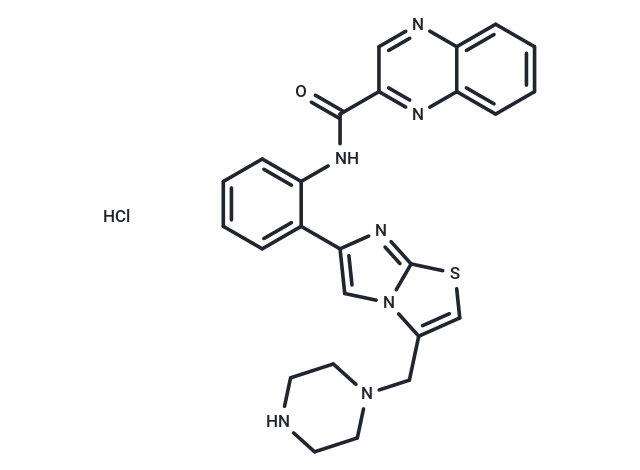Shopping Cart
- Remove All
 Your shopping cart is currently empty
Your shopping cart is currently empty

SRT1720 hydrochloride (SRT1720 HCl) is a selective activator of SIRT1 (EC1.5: 0.16 μM) and shows less potent activities on SIRT2/SIRT3 (EC1.5s: 37 μM/300 μM).

| Pack Size | Price | Availability | Quantity |
|---|---|---|---|
| 1 mg | $63 | In Stock | |
| 2 mg | $82 | In Stock | |
| 5 mg | $142 | In Stock | |
| 10 mg | $263 | In Stock | |
| 25 mg | $415 | In Stock | |
| 50 mg | $591 | In Stock | |
| 100 mg | $843 | In Stock | |
| 200 mg | $1,160 | In Stock | |
| 500 mg | $1,720 | In Stock | |
| 1 mL x 10 mM (in DMSO) | $233 | In Stock |
| Description | SRT1720 hydrochloride (SRT1720 HCl) is a selective activator of SIRT1 (EC1.5: 0.16 μM) and shows less potent activities on SIRT2/SIRT3 (EC1.5s: 37 μM/300 μM). |
| Targets&IC50 | SIRT1:0.16 μM(EC1.5, cell free) |
| In vitro | SRT1720 is an activator of SIRT1 (EC1.5 = 0.16 μM and maximum activation = 781%). SRT1720 is selective for activation of SIRT1 versus the closest sirtuin homologues, SIRT2 and SIRT3 (SIRT2: EC1.5 = 37 μM; SIRT3: EC1.5 > 300 μM) [1]. |
| In vivo | SRT1720 exhibited a pharmacokinetic profile suitable for in vivo evaluation in both mouse (bioavailability = 50%, terminal t1/2 = ~5 h, Area Under the Curve (AUC) = 7,892 ng h/ml/) and rat (bioavailability = 25%, terminal t1/2 = ~8.4 h, AUC = 3,714 ng/h/ml). In DIO mice, fasting blood glucose levels are elevated (120–150 mg dl?1 range) after being placed on a high-fat diet. Administration of SRT1720 reduced fed glucose levels after 1 week of treatment with further reduction after 3 weeks of treatment that continued through 10 weeks of dosing. Glucose excursion during an intraperitoneal glucose tolerance test was also significantly reduced in the SRT1720 group, and comparable to rosiglitazone, a PPARγ activator that has been used to treat type 2 diabetes [1]. SRT1720 attenuated stress-induced premature cellular senescence and protected against emphysema induced by cigarette smoke and elastase in mice [2]. In animal tumour model studies, SRT1720 inhibited MM tumour growth. SRT1720 enhanced the cytotoxic activity of bortezomib or dexamethasone [3]. |
| Kinase Assay | In the SIRT1 FP assay, SIRT1 activity was monitored using a 20 amino acid peptide (AcGlu-Glu-Lys(biotin)-Gly-Gln-Ser-Thr-Ser-Ser-His-Ser-Lys(Ac)-Nle-Ser-Thr-Glu-Gly–Lys(MR121 or Tamra)-Glu-Glu-NH2) derived from the sequence of p53. The peptide was N-terminally linked to biotin and C-terminally modified with a fluorescent tag. The reaction for monitoring enzyme activity was a coupled enzyme assay where the first reaction was the deacetylation reaction catalyzed by SIRT1 and the second reaction was cleavage by trypsin at the newly exposed lysine residue. The reaction was stopped and streptavidin was added in order to accentuate the mass differences between substrate and product. In total, 290,000 compounds were screened and 127 hits were confirmed. The sensitivity of the FP assay allowed identification of compounds that exhibited low level activation of SIRT1 (≥17% activation at 20 μM) producing multiple classes of activators representing distinct structural classes. The fluorescence polarization reaction conditions were as follows: 0.5 μM peptide substrate, 150 μM βNAD+, 0-10 nM SIRT1, 25 mM Tris-acetate pH 8, 137 mM Na-Ac, 2.7 mM K-Ac, 1 mM Mg-Ac, 0.05% Tween-20, 0.1% Pluronic F127, 10 mM CaCl2, 5 mM DTT, 0.025% BSA, and 0.15 mM nicotinamide. The reaction was incubated at 37°C and stopped by addition of nicotinamide, and trypsin was added to cleave the deacetylated substrate. This reaction was incubated at 37°C in the presence of 1 μM streptavidin. Fluorescent polarization was determined at excitation (650 nm) and emission (680 nm) wavelengths [1]. |
| Cell Research | Cell viability was assessed with a colorimetric assay using MTT as described previously. Apoptosis assay was quantified using Annexin V-FITC/Propidium iodide (PI) apoptosis detection kit, as per manufacturer's instructions, followed by analysis on FACS Calibur [3]. |
| Animal Research | Sirtinol (2 mg/kg) was administered by peritoneal injection, whereas SRT1720 (100 mg/kg) was administered through oral gavage 1 hour prior to CS exposure daily for 3 days. In a separate experiment, SRT1720 (25, 50, and 100 mg/kg) or PHA-408 (50 mg/kg) was dissolved in 0.5% carboxymethylcellulose containing 0.025% Tween 20 and injected via oral gavage into the conscious mice 24 hours prior to elastase administration, which was repeated daily (5 days per week) until 21 days after elastase administration. To study the therapeutic effect on emphysema, SRT1720 (100 mg/kg) was orally administered daily for 2 weeks after the development of elastase-induced emphysema [2]. |
| Alias | SRT1720 HCl, SRT 1720 Hydrochloride |
| Molecular Weight | 506.22 |
| Formula | C25H24ClN7OS |
| Cas No. | 1001645-58-4 |
| Smiles | Cl.O=C(Nc1ccccc1-c1cn2c(CN3CCNCC3)csc2n1)c1cnc2ccccc2n1 |
| Relative Density. | 1.58 g/cm3 |
| Storage | Powder: -20°C for 3 years | In solvent: -80°C for 1 year | Shipping with blue ice. | |||||||||||||||||||||||||||||||||||
| Solubility Information | H2O: < 1 mg/mL (insoluble or slightly soluble) DMSO: 55 mg/mL (108.65 mM), Sonication is recommended. Ethanol: < 1 mg/mL (insoluble or slightly soluble) | |||||||||||||||||||||||||||||||||||
Solution Preparation Table | ||||||||||||||||||||||||||||||||||||
DMSO
| ||||||||||||||||||||||||||||||||||||

Copyright © 2015-2025 TargetMol Chemicals Inc. All Rights Reserved.